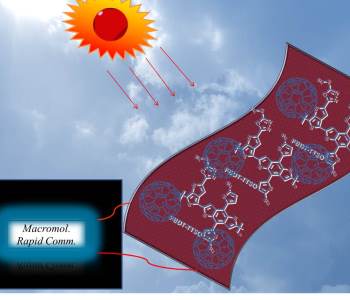 Polymer solar cells (PSCs) have attracted much attention due to their advantages of easy fabrication, simple device structure, low cost, light weight, and the capability to be fabricated into flexible devices via solution processing. PSC efficiency can be improved by two major strategies. On the one hand, researchers try reducing the bandgap of polymers to harvest more sunlight, yielding a higher short-circuit current density JSC. On the other hand, the highest occupied molecular orbital (HOMO) energy level of the polymer can be decreased to get a higher low open circuit voltage VOC. The critical challenge in obtaining highly efficient PSCs is to narrow the bandgap of the respective polymer without sacrificing efficient charge separation as well as high VOC.
Polymer solar cells (PSCs) have attracted much attention due to their advantages of easy fabrication, simple device structure, low cost, light weight, and the capability to be fabricated into flexible devices via solution processing. PSC efficiency can be improved by two major strategies. On the one hand, researchers try reducing the bandgap of polymers to harvest more sunlight, yielding a higher short-circuit current density JSC. On the other hand, the highest occupied molecular orbital (HOMO) energy level of the polymer can be decreased to get a higher low open circuit voltage VOC. The critical challenge in obtaining highly efficient PSCs is to narrow the bandgap of the respective polymer without sacrificing efficient charge separation as well as high VOC.
Thieno[3,4-b]thiophene (TT)-based low band-gap polymers have been very successful in the past years. However, their open circuit voltages (VOC) are usually low. The general strategy to improve VOC is to decrease the HOMO energy level of the polymer by introducing substituents with strong electron withdrawing ability, such as ester (COOR), ketone (COR), sulfonyl (SO2R), fluorine (F) and trifluoromethyl groups (CF3).
Yang et al. demonstrate a new method to regulate HOMO energy levels of TT-based polymers by introducing electron-deficient aromatic heterocyclic moieties. The 1,3,4-Oxadiazol motif has widely been used in OLEDs and is also attractive for application in organic photovoltaics. The corresponding polymer PBDT-TTSO exhibits a deep lying HOMO energy level of -5.32 eV with a desirable VOC of >0.78 V comparable to the fluorine substituted PTB7-Th in standard bulk heterojunction solar cells.
The stability of this new polymer was investigated by treating with different oxidants. Interestingly, the oxidation products still maintained high efficiencies compared to the original PBDT-TTSO with an efficiency reduction lower than 30%. The work demonstrates a new method to tune the HOMO level of TT-based polymers by introducing different electron-deficient aromatic heterocyclic moieties, and analyses the susceptibly of the thioether sulfur atom to oxidation which should be taken into account in future molecular design.

















